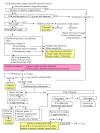Can a management pathway for chronic cough in children improve clinical outcomes: protocol for a multicentre evaluation
- PMID: 21054884
- PMCID: PMC2989328
- DOI: 10.1186/1745-6215-11-103
Can a management pathway for chronic cough in children improve clinical outcomes: protocol for a multicentre evaluation
Abstract
Background: Chronic cough is common and is associated with significant economic and human costs. While cough can be a problematic symptom without serious consequences, it could also reflect a serious underlying illness. Evidence shows that the management of chronic cough in children needs to be improved. Our study tests the hypothesis that the management of chronic cough in children with an evidence-based management pathway is feasible and reliable, and improves clinical outcomes.
Methods/design: We are conducting a multicentre randomised controlled trial based in respiratory clinics in 5 major Australian cities. Children (n = 250) fulfilling inclusion criteria (new patients with chronic cough) are randomised (allocation concealed) to the standardised clinical management pathway (specialist starts clinical pathway within 2 weeks) or usual care (existing care until review by specialist at 6 weeks). Cough diary, cough-specific quality of life (QOL) and generic QOL are collected at baseline and at 6, 10, 14, 26, and 52 weeks. Children are followed-up for 6 months after diagnosis and cough resolution (with at least monthly contact from study nurses). A random sample from each site will be independently examined to determine adherence to the pathway. Primary outcomes are group differences in QOL and proportion of children that are cough free at week 6.
Discussion: The clinical management pathway is based on data from Cochrane Reviews combined with collective clinical experience (250 doctor years). This study will provide additional evidence on the optimal management of chronic cough in children.
Trial registration: ACTRN12607000526471.
Figures
References
-
- Irwin RS, Baumann MH, Bolser DC, Boulet LP, Braman SS, Brightling CE, Brown KK, Canning BJ, Chang AB, Dicpinigaitis PV, Eccles R, Glomb WB, Goldstein LB, Graham LM, Hargreave FE, Kvale PA, Lewis S, McCool FD, McCrory DC, Prakash UB, Pratter MR, Rosen MJ, Schulman E, Shannon JJ, Smith Hammond C, Tarlo SM. Diagnosis and Management of Cough Executive Summary: ACCP Evidence-Based Clinical Practice Guidelines. Chest. 2006;129:1S–23. doi: 10.1378/chest.129.1_suppl.1S. - DOI - PMC - PubMed
-
- Britt H, Miller GC, Knox S, Charles J, Valenti L, Pan Y, Henderson J, Bayram C, O'Halloran J, Ng A. General Practice Activity in Australia 2003-2004. Australian Institute of Health and Welfare. 2004. AIHW Cat. No. GEP 16.
Publication types
MeSH terms
LinkOut - more resources
Full Text Sources
Medical



